BIOL 1001 LSU Exam 3 Chs 7,8,9 Crousillac
1/98
There's no tags or description
Looks like no tags are added yet.
Name | Mastery | Learn | Test | Matching | Spaced |
|---|
No study sessions yet.
99 Terms
light-dependent reaction
happens ONLY in daytime, occurs in thylakoid membrane b/c that's where chlorophyll is located,
oxygen released as by-product
H2O + NADP+ + ADP => O2 + NADPH + ATP

what is required for the light dependent reaction?
water and sunlight
flow of electrons in light dependent reaction
water → PS2 → PS1 → NADP
products of light dependent reaction
ATP & NADPH
light-independent reaction (Calvin Cycle)
happens 24/7 and occurs in the stroma
CO2 + ATP + NADPH + H2O => C6H12O6 + ADP + NADP+
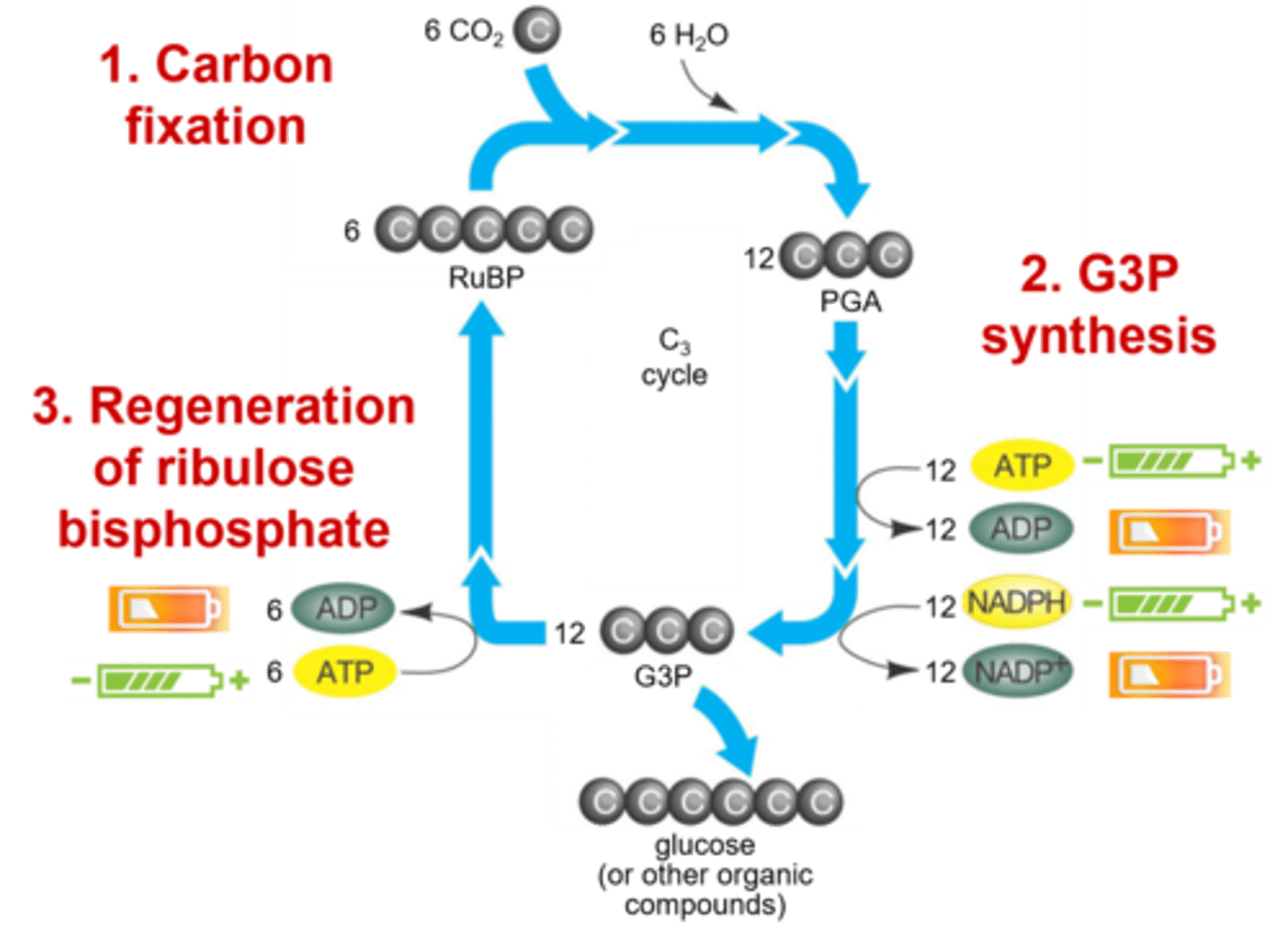
inputs of light-independent reaction
CO2, ATP, NADPH
output of light-independent reaction
glucose
photosynthesis
transforms light energy trapped by chloroplasts into chemical bond energy and stores that energy in sugar and other organic molecules
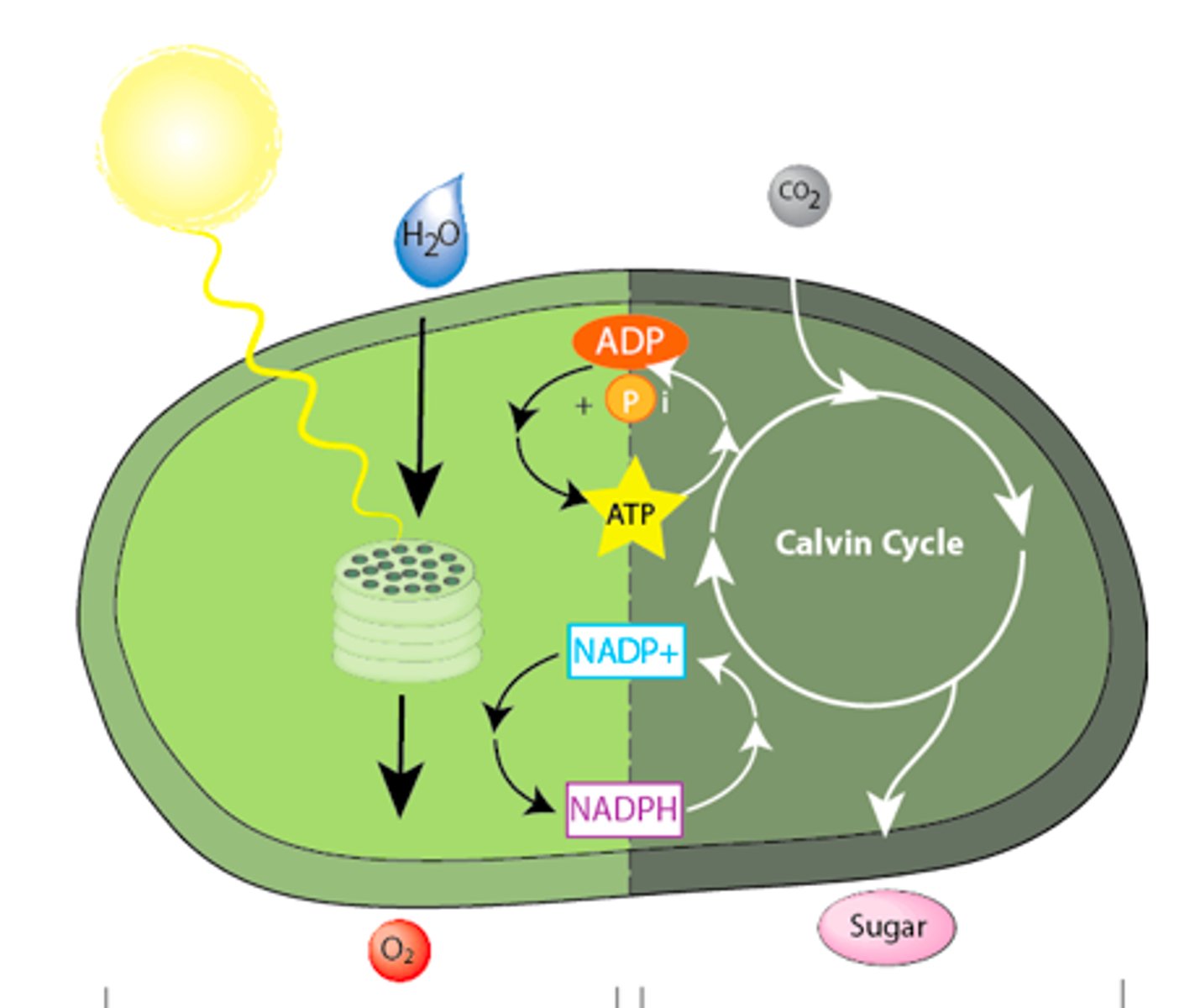
what type of chemical reaction is photosynthesis
endergonic
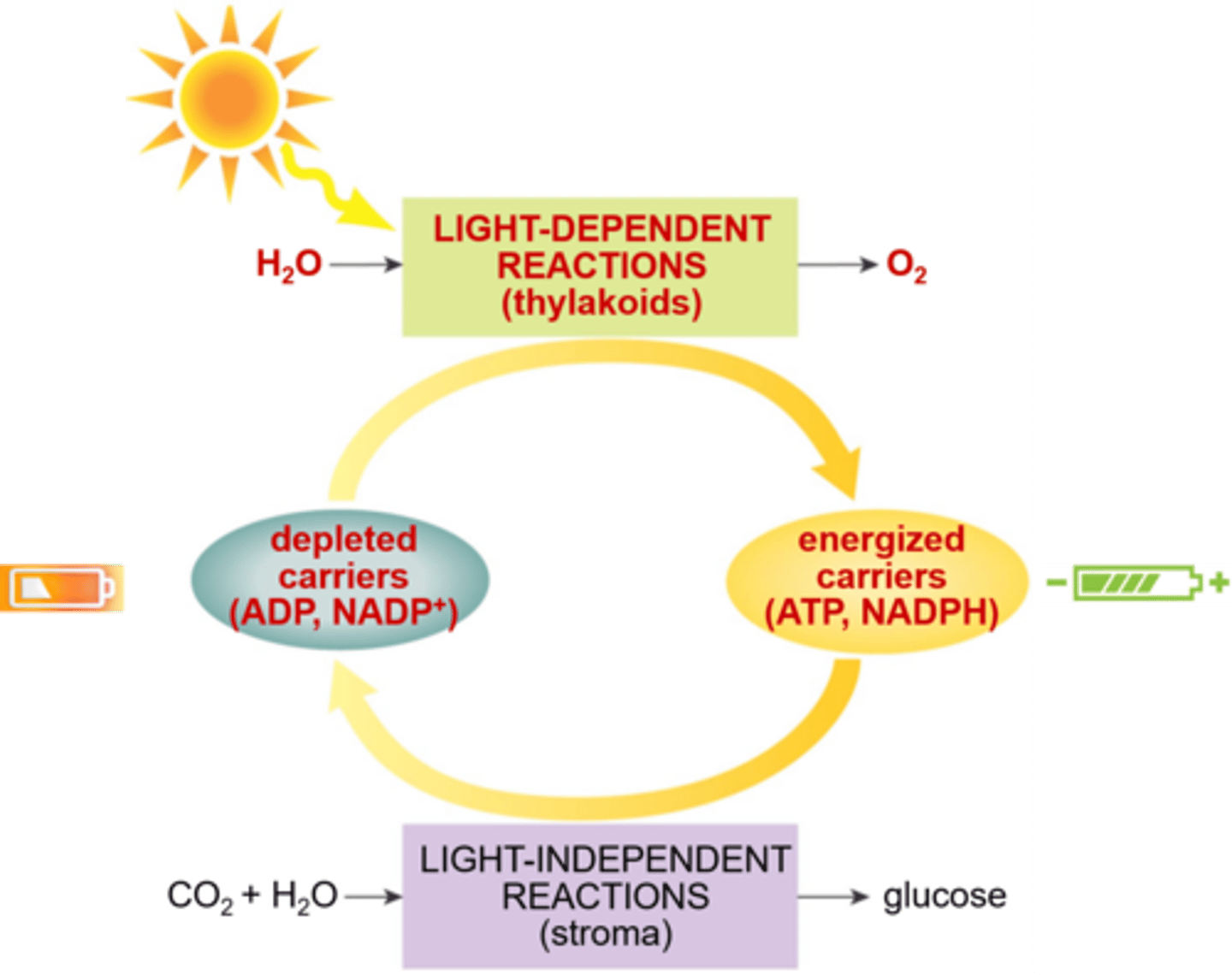
stomata
tiny holes that allow water & CO2 to enter the leaf
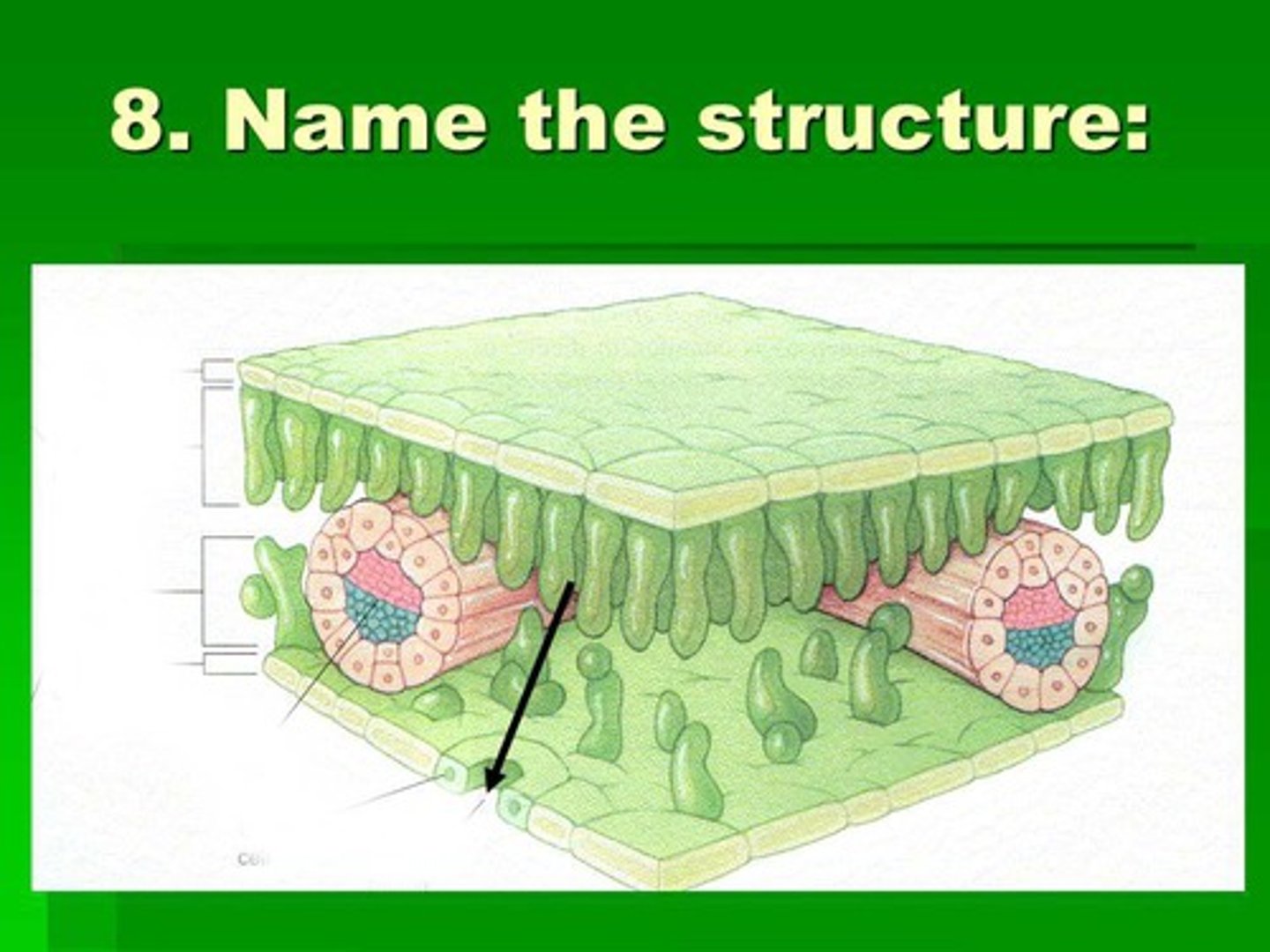
vascular bundle
like a vein for a leaf, carries water and sugar throughout the plant
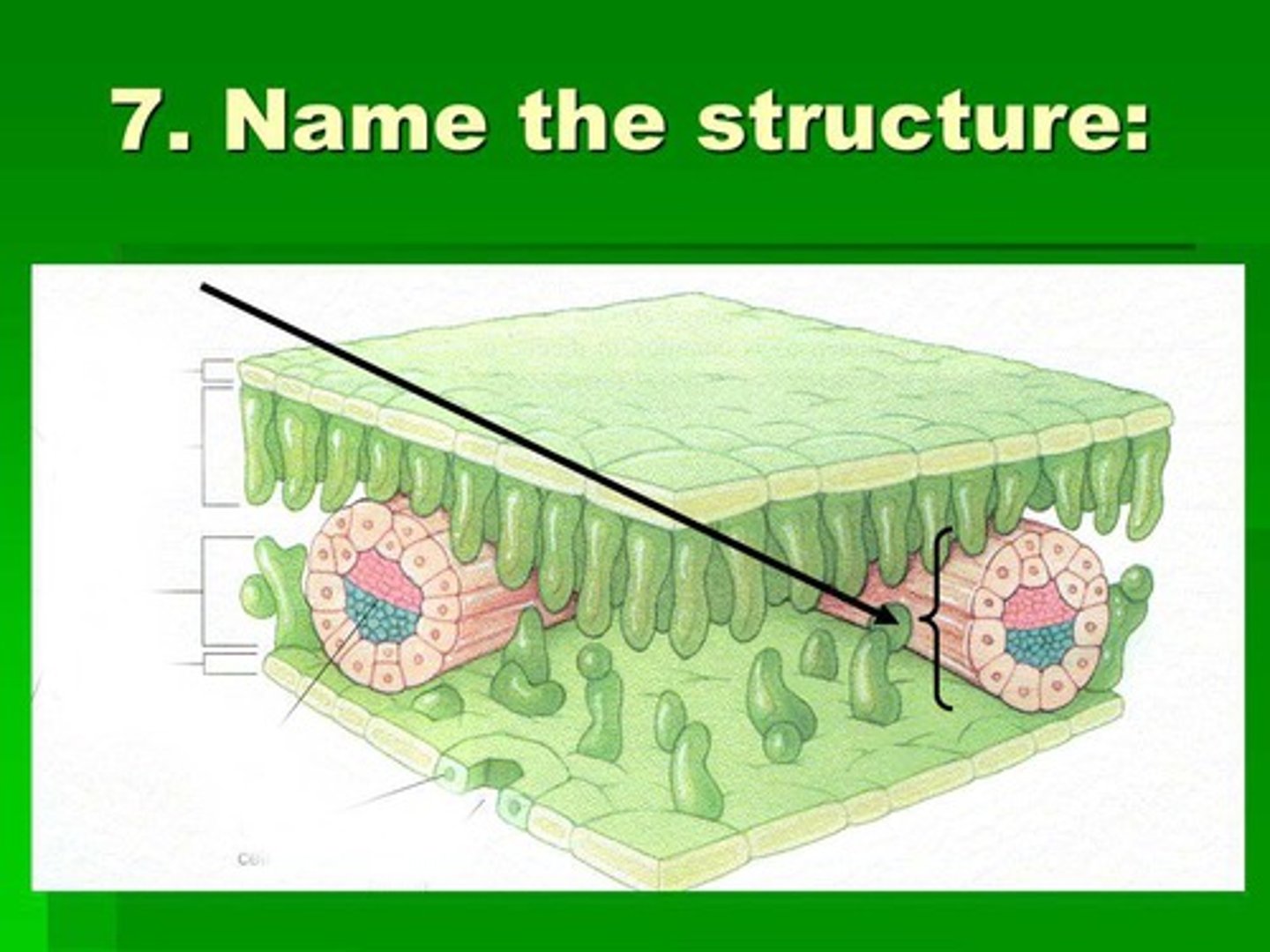
mesophyll cells
found in the middle of the leaf, contain chloroplasts
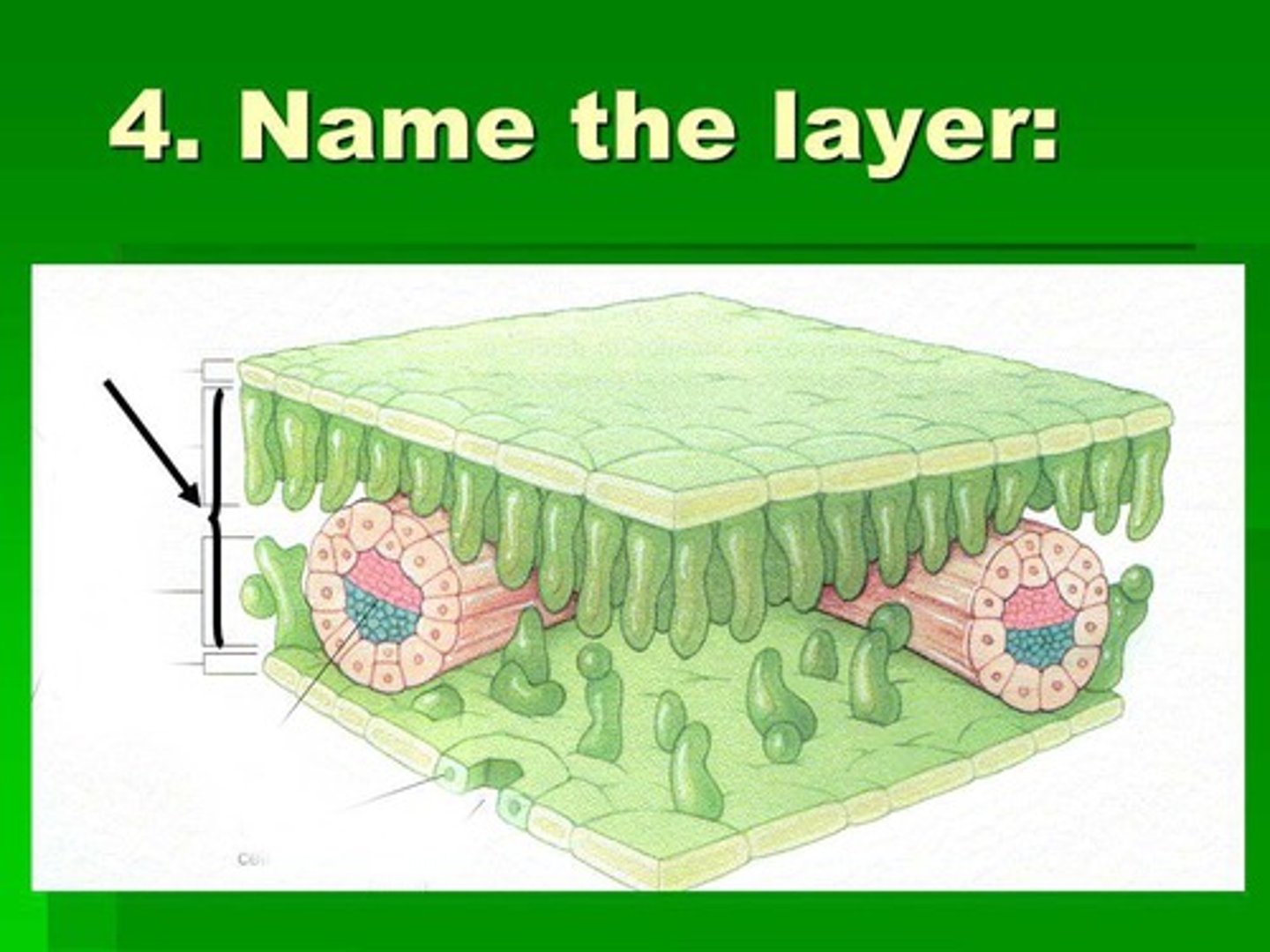
cuticle
waxy layer surrounding the leaf that seals water in
the shorter the wavelength....
the higher the energy
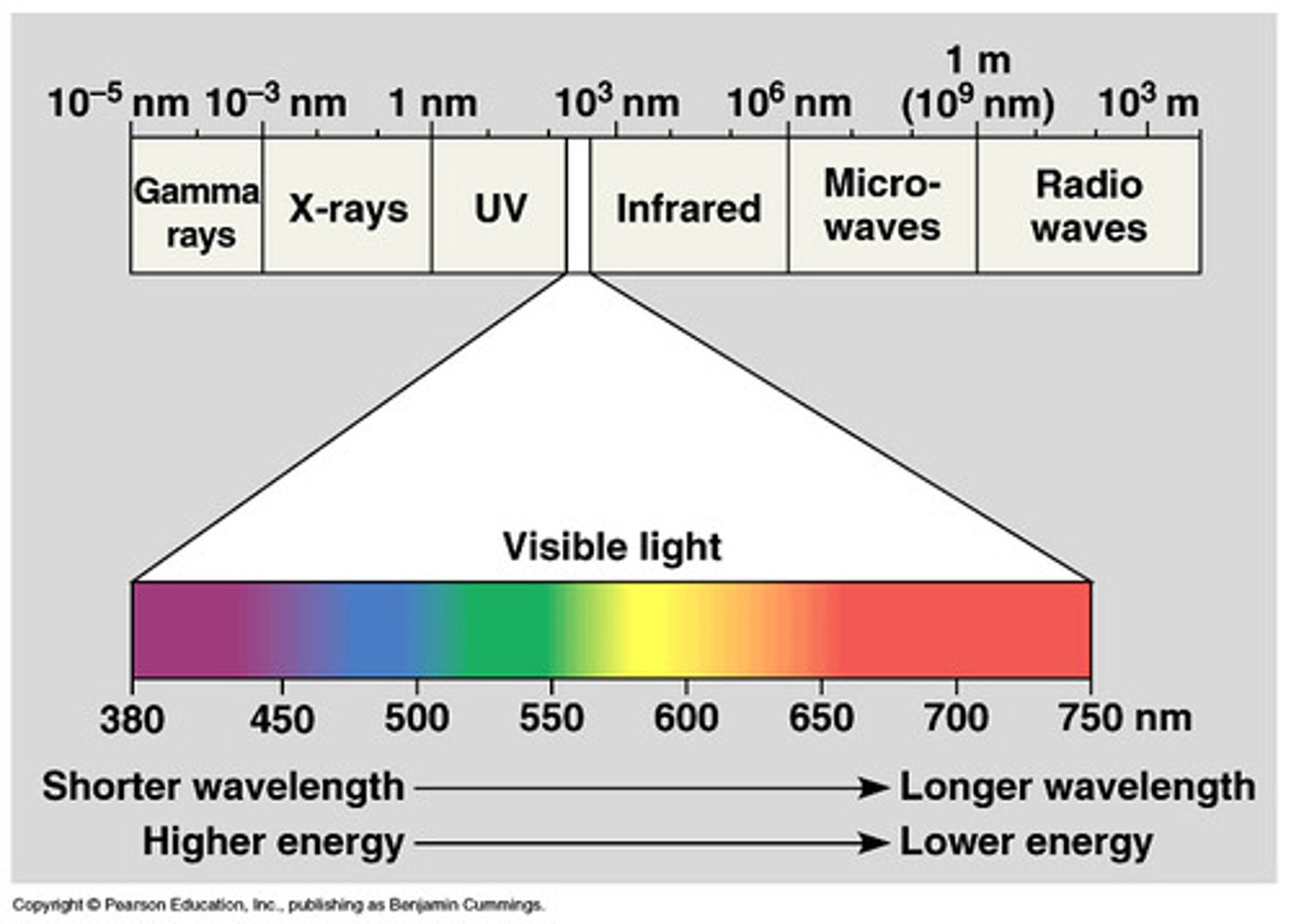
chemiosmosis
In the thylakoid, as electrons move down the electron transport chain, protons (H+) are pumped, against their concentration gradient, to one side of the thylakoid membrane. As they diffuse to the other side, they activate an enzyme called ATP synthase that is used to make ATP.
energy released from electrons in ETC used to actively transport protons into thylakoid, builds gradient
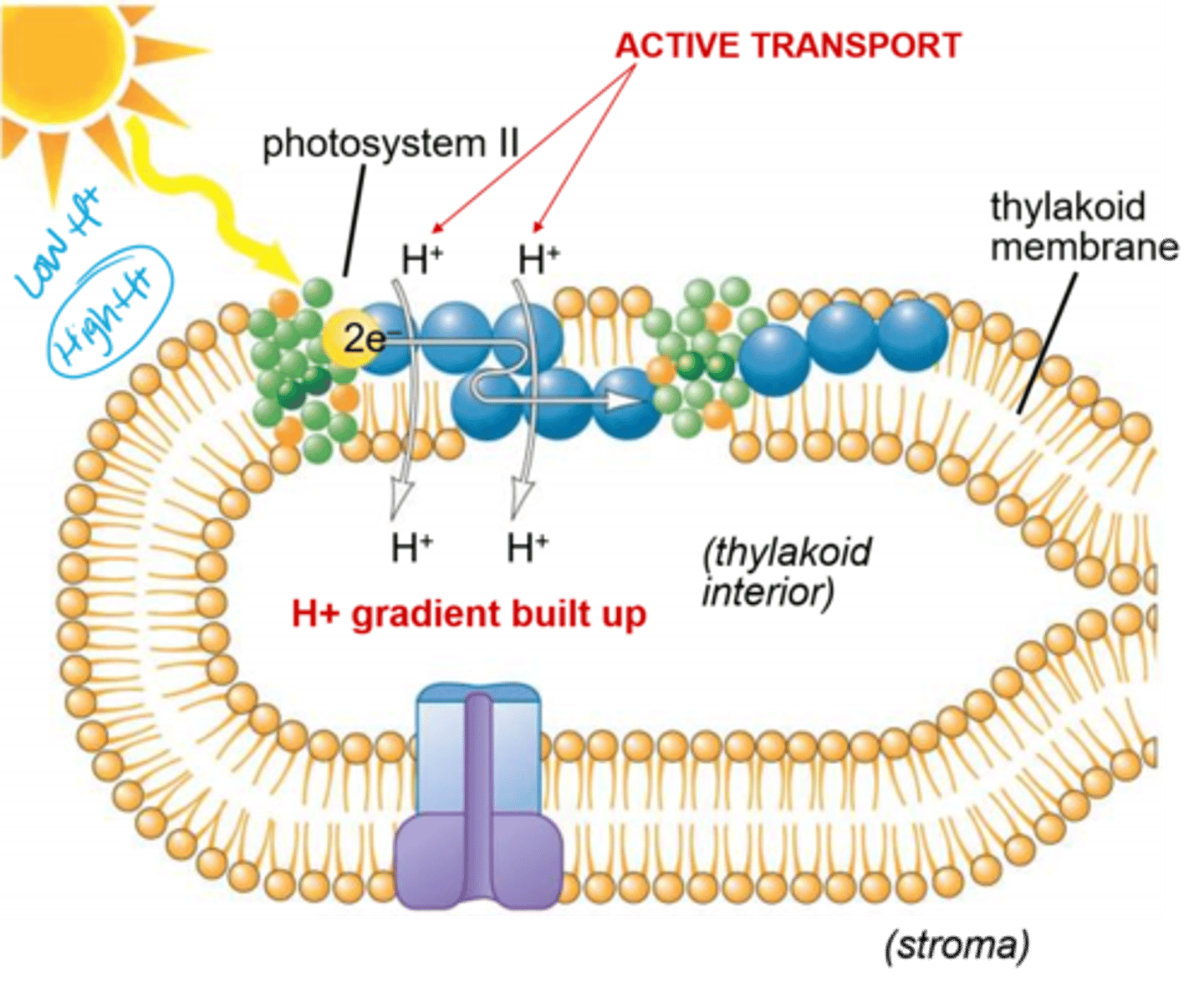
site of photosynthesis
chloroplasts
chlorophyll
green pigment that gives a leaf its color
responsible for the absorption of the light energy that drives photosynthesis
located in thylakoid membrane
thylakoid
flattened membranous sac inside the chloroplast
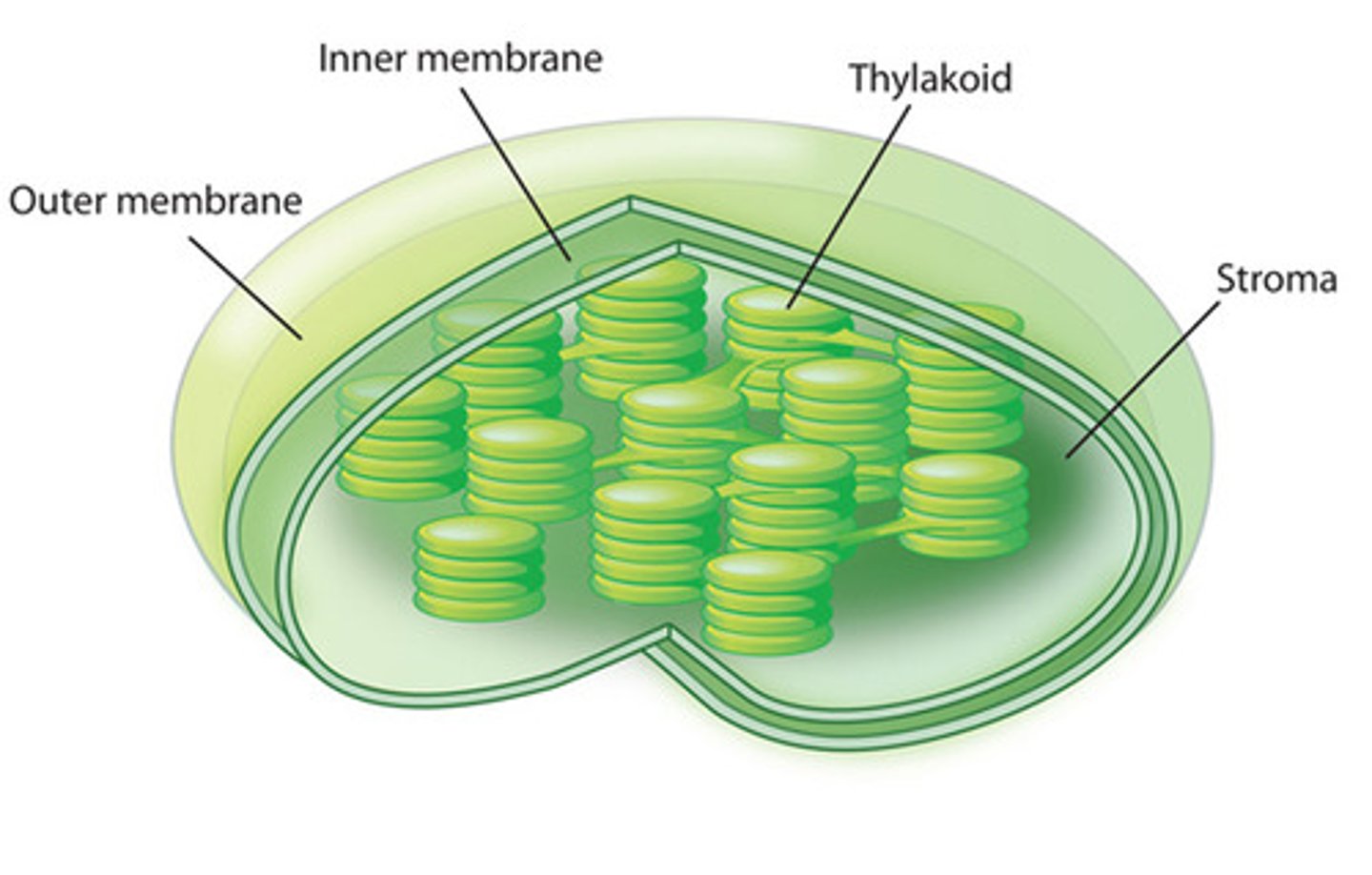
stroma
fluid-filled space outside the thylakoids within the chloroplast
accessory pigments
carotenoids and phycocyanins
pigments
substances that absorb visible light
photosystems
assemblies which turn light energy into chemical energy in the thylakoid membranes
What is the purpose of having two photosystems in the light-dependent reactions?
The two generate different energy carriers
When less water is available during a drought, why is the rate of photosynthesis in plants reduced?
Fewer electrons are around to fuel the ETC
chemiosmosis: ATP synthesis
keeps H+ concentration high inside thylakoid, diffuses out to make ATP
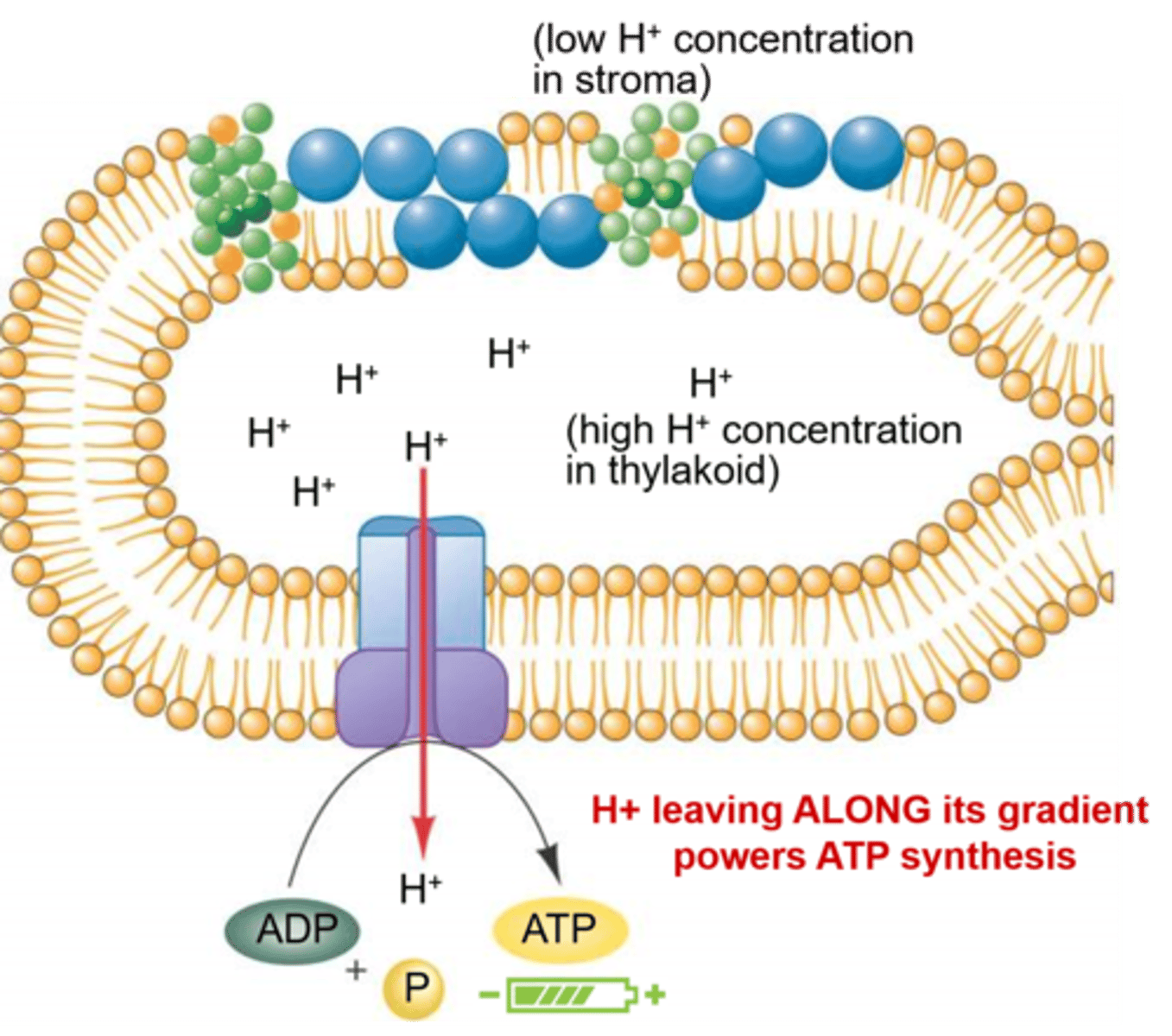
what step is most important in the Calvin Cycle?
step 1: carbon fixation
steps of the Calvin Cycle (light-independent)
1. Carbon fixation: acquiring Carbon from the atmosphere and incorporating it into a larger organic molecule. RuBP is converted to PGA.
2. PGA is made into G3P. Energy from NADPH and ATP (from the light-dependent reaction) is used.
3. 2 G3P molecules are made into glucose. The remaining G3P molecules are made back into RuBP. Requires ATP energy.
RuBP SOAKS UP CO2, CONVERTS TO PGA
PGA CONVERTS TO G3P, ELECTRONS AND ATP USED
REST OF G3P MAKES MORE RuGP
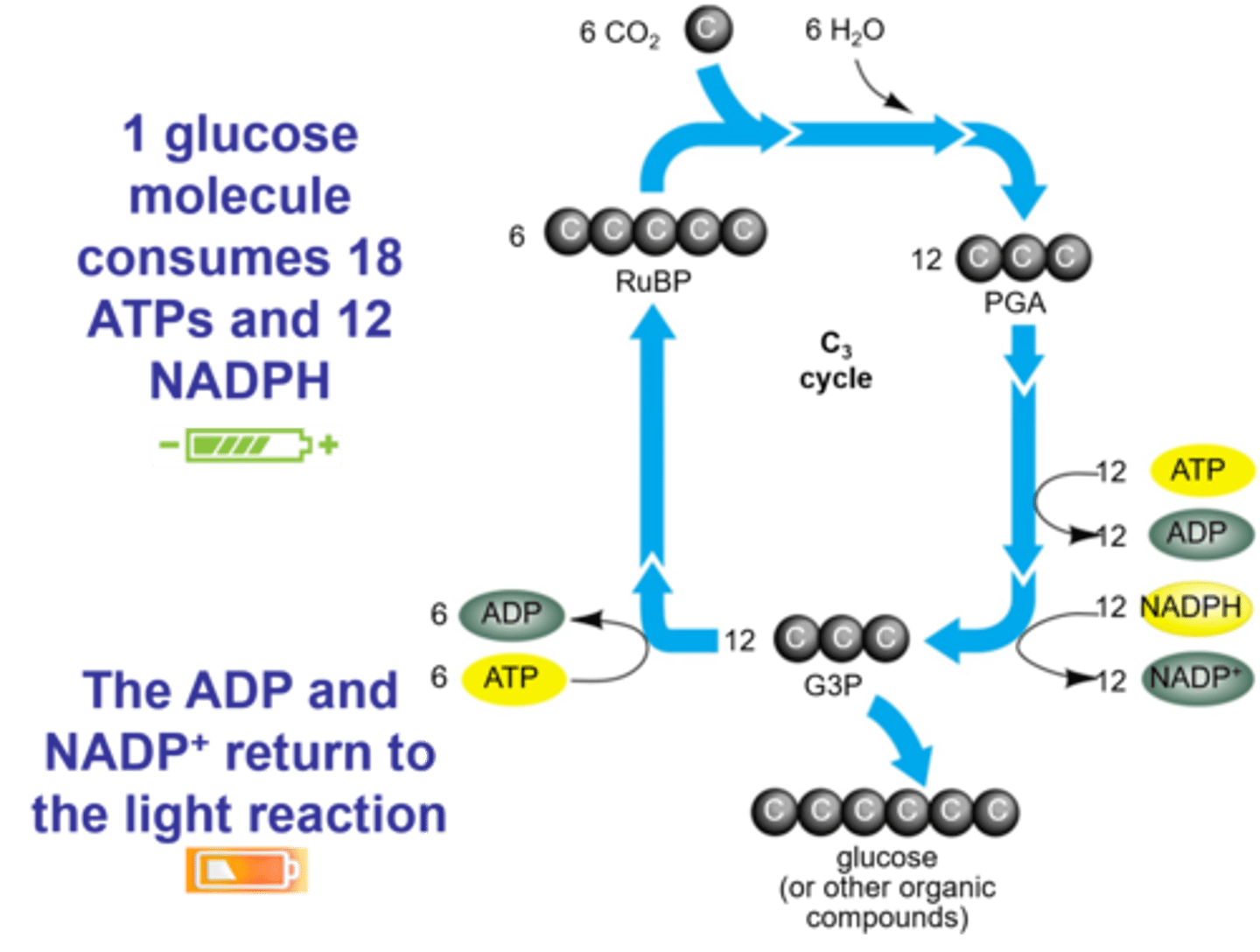
In the Calvin cycle, where do the carbons used to synthesize glucose originate?
CO2
How are the light-dependent reactions and the Calvin cycle related?
The energy-carrier molecules of the light- dependent reactions fuel the Calvin cycle.
What is responsible for the beautiful shades of red, orange, and gold in autumn leaves?
Accessory pigments become visible after chlorophyll breaks down.
where does glycolysis occur?
cytoplasm
is oxygen required for glycolysis?
NO
inputs of glycolysis
1 glucose molecule
outputs of glycolysis
2 pyruvates(pyruvic acid)
2 NADH molecules
2 net ATPs
fermentation
happens when there is not enough oxygen to completely breakdown glucose through cellular respiration; glucose is partially broken down by glycolysis & occurs to regenerate NAD needed for glycolysis, so 2 ATPs can be made every time glycolysis occurs
anaerobic (without O2)
NO ATP production
partial degradation of sugars; regenerates NAD+
mitochondria
POWERHOUSE OF THE CELL
produces ATP
3 metabolic stages of cellular respiration
1. Glycolysis
2. Krebs cycle (Citric Acid Cycle)
3. ETC & oxidative phosphorylation
Glycolysis
harvests chemical energy by breaking down glucose to pyruvate
catabolic pathway during which 6-carbon glucose split into two 3-carbon sugars, then rearranged by stepwise process that produces 2 pyruvic acid molecules
occurs in cytoplasm
occurs w/ or w/out O2
net result is 2 ATP and 2 NADH
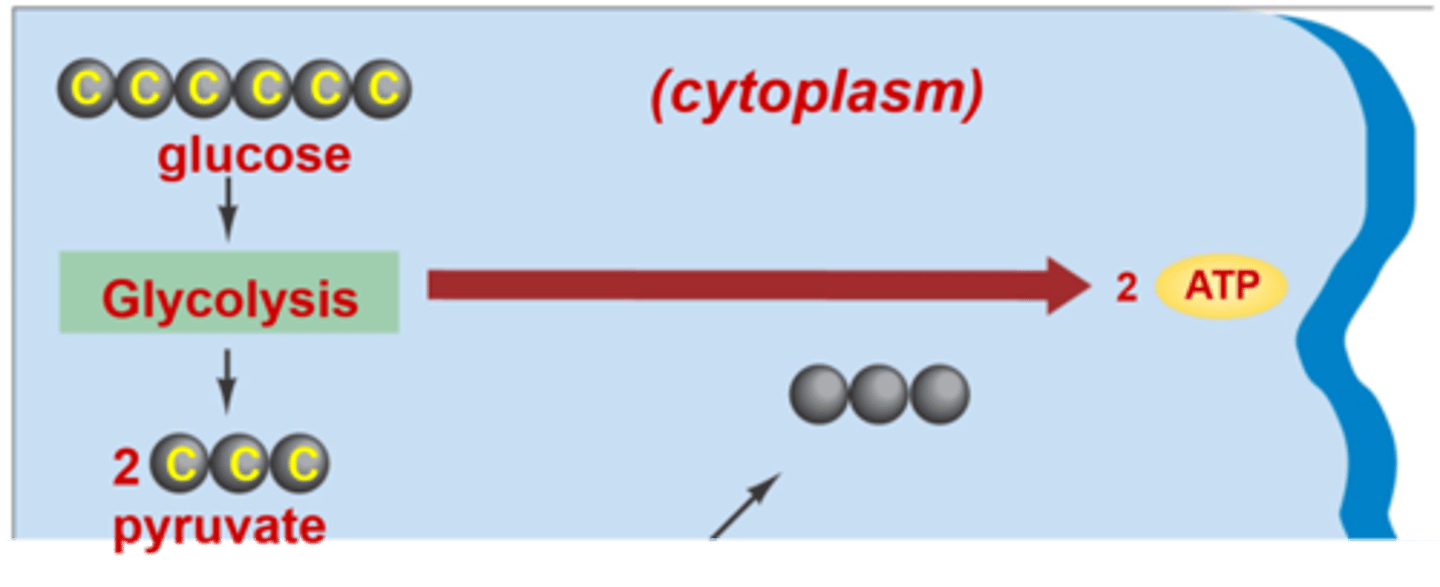
2 phases of glycolysis
1. glucose activation
2. energy harvest

glucose activation
uses cellular ATP to phosphorylate (adds a phosphate group to) the glycolysis intermediates
costs 2 ATP per glucose
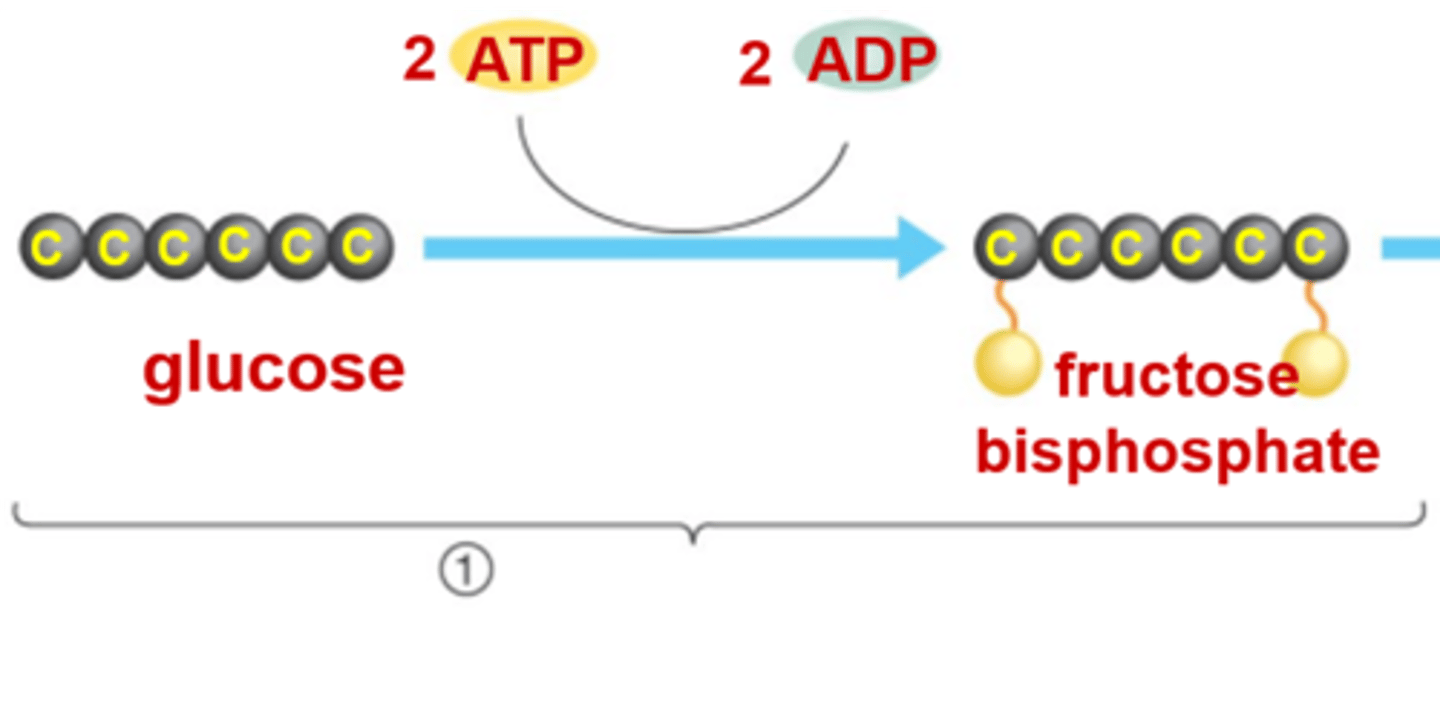
energy harvest
produces ATP
yields 4 ATP molecules per glucose
2 molecules of NADH per glucose

Glycolysis is distinct from cellular respiration because...
Glycolysis does not occur in the mitochondria
two types of fermentation/2 common products of pyruvate acid
ethanol/alcohol
lactic acid
alcoholic fermentation
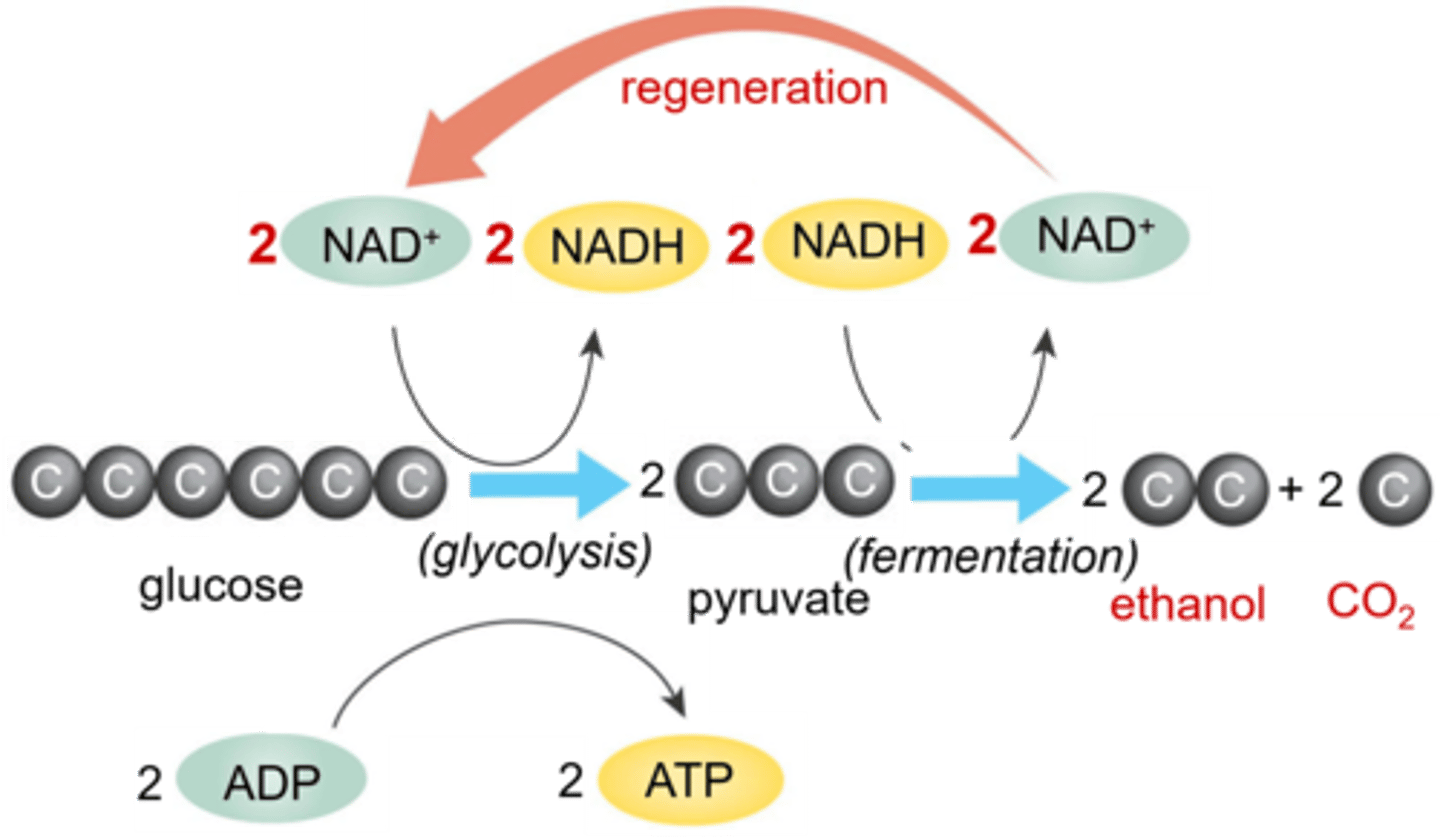
lactic fermentation

How can glycolysis continue producing energy when oxygen is not present?
Fermentation regenerates the NAD+ needed for glycolysis by allowing pyruvate to accept electrons and H+ from NADH
You help a friend move, and the next day, your arms and legs are sore. What caused the soreness?
Your overworked muscles did not get enough O2 and switched to fermentation, which builds up lactate
bridge reaction
connects glycolysis to the Krebs cycle, converts pyruvic acid to acetyl CoA
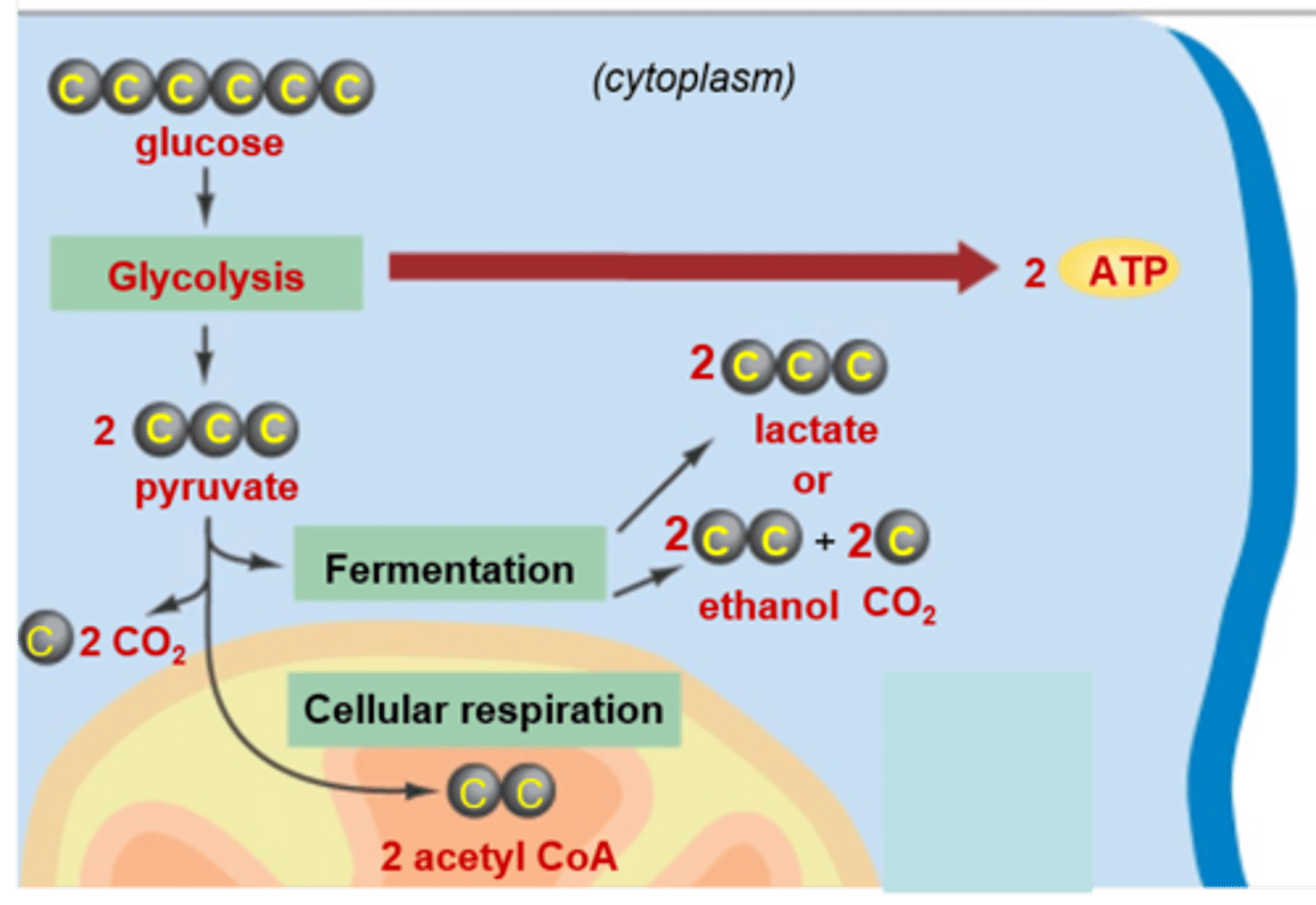
steps of bridge reaction
1. removal of CO2
2. Production of NADH from NAD+;
two molecules of NADH per glucose molecule
3. attachment of a coenzyme A to form acetyl CoA
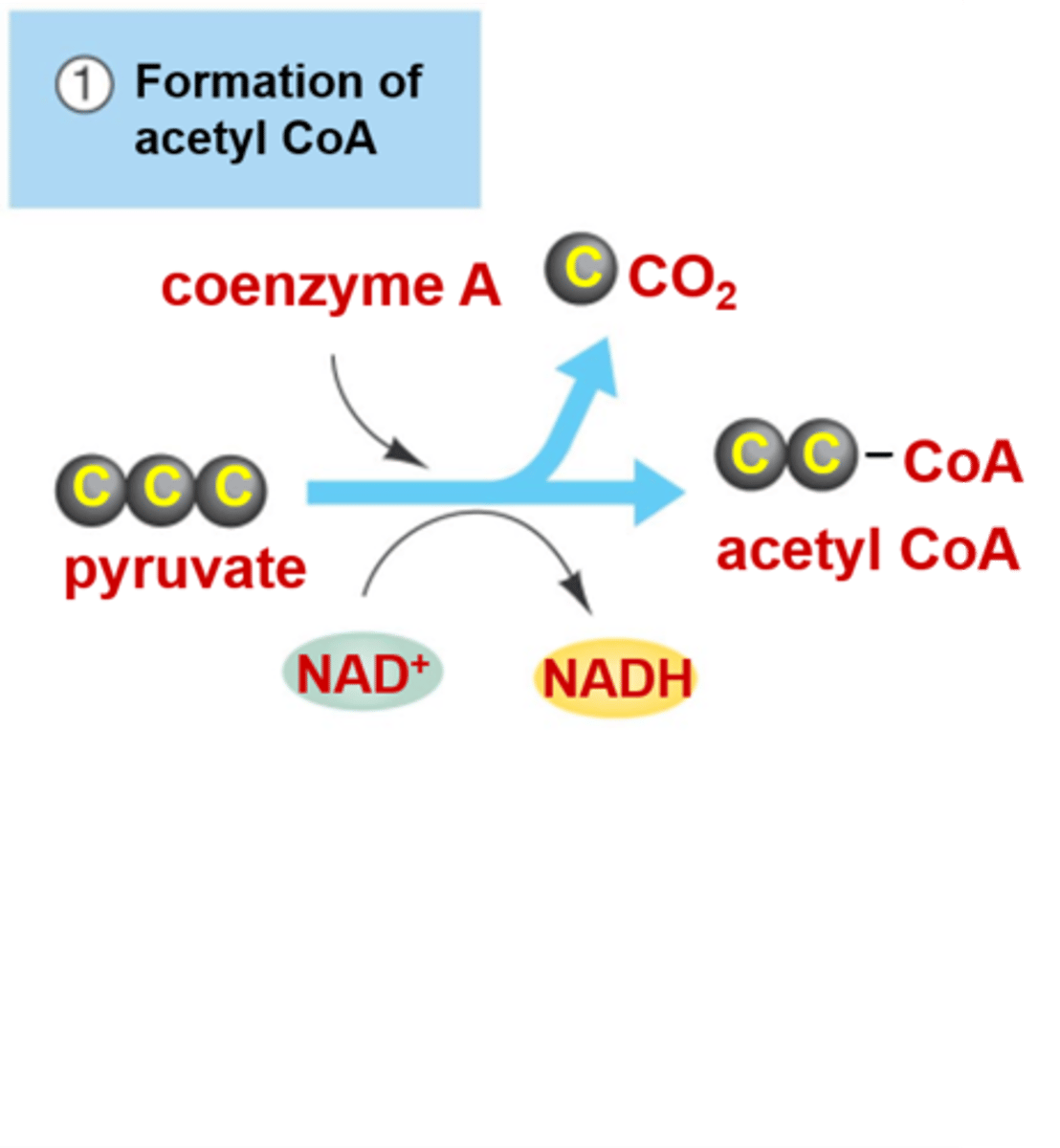
Kreb's Cycle
occurs in mitochondrial matrix (innermost part of mitochondria)
completes the breakdown of glucose
for every molecule of glucose entering glycolysis, 2 pyruvates enter Krebs Cycle
**has to turn twice to breakdown 1 molecule

Electron Transport System
located in inner mitochondrial membrane
accepts energy as electrons from NADH & FADH2
uses energy to make ATP by oxidative phosphorylation
produces most of the ATP of cellular respiration
**does NOT actually produce ATP, just maintains proton gradient
products of Krebs Cycle
NADH, FADH2, small amount of ATP
steps of Electron Transport Chain
1. Electrons pass through series of enzymes & other proteins (ETC)
2. Their energy is used to pump H+ from the matrix into intermembrane compartment, creates a gradient
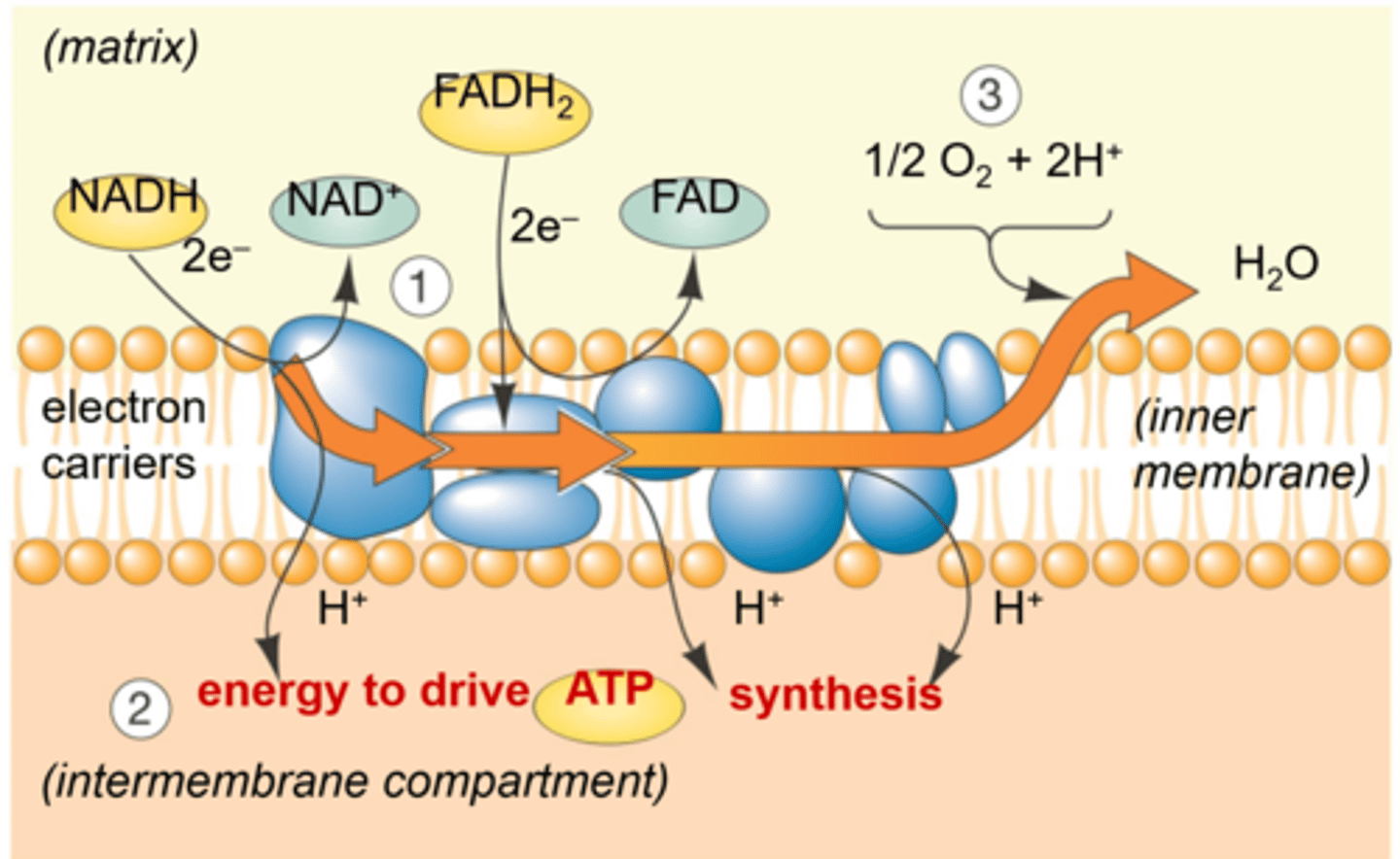
chemiosmosis (ATP synthesis)
coupling of exergonic electron flow down an ETC to endergonic ATP production by the creatiohn of a proton gradient across a membrane
occurs in inner mitochondrial membrane
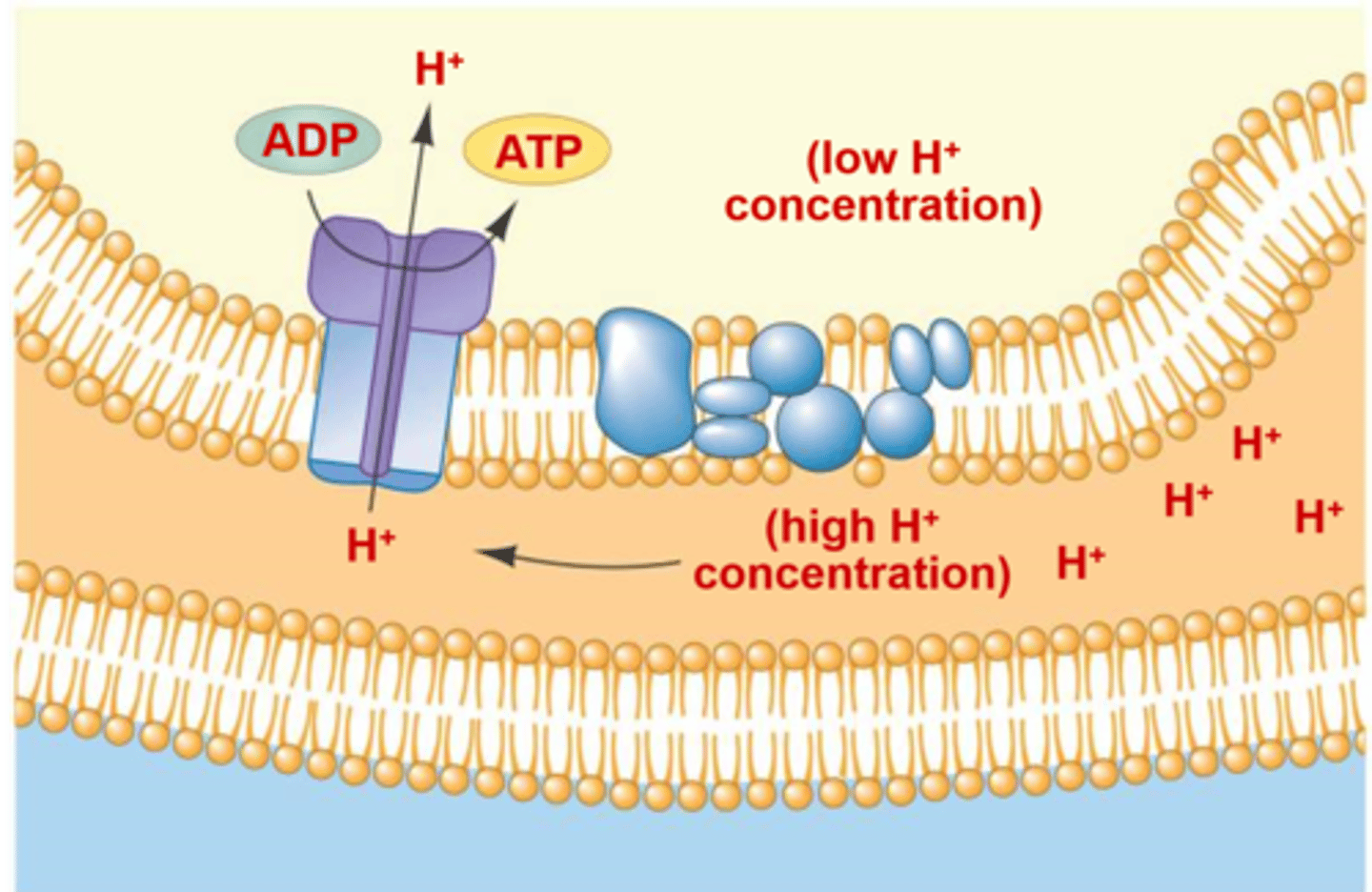
overall summary of glycolysis, Krebs cycle & ETC
C6H12O6 + 36ADP + 6O2 →
6CO2 + 36ATP +42H2O
input of bridge reaction
2 pyruvates produced from glycolysis
outputs of bridge reaction
2 NADH & 2 acetyl CoA molecules
inputs of Krebs Cycle
2 acetyl CoA molecules produced during bridge reaction
outputs of Krebs Cycle
(2 turns)
6 NADH
2 FADH2
2 ATPs
inputs of chemiosmosis/ETC
electrons carried by NADH & FADH2
outputs of chemiosmosis/ETC
32-34 ATP, water
why is oxygen important in chemiosmosis/ETC
ultimate acceptor of electrons, if no oxygen present, no ATP gets made
role of ATP synthase
protons diffusing back into the matrix activate ATP synthase enzyme, & produce ATP in the process
cellular reproduction/cell division
process in which genetic info of a cell is passed along to the next generation of cells
involves division of a parent cell into 2 daughter cells
replication of DNA
equal distribution of DNA to opposite ends of dividing cell
separation into 2 daughter cells
interphase
period of cell cycle when cell is not dividing
90% of cell cycle
high metabolic activity
chromosomes & organelles are duplicated

steps of interphase
G1: cell growth and differentiation
S: synthesis of DNA, chromosomes duplicated
produces sister chromatids
G2: cell growth
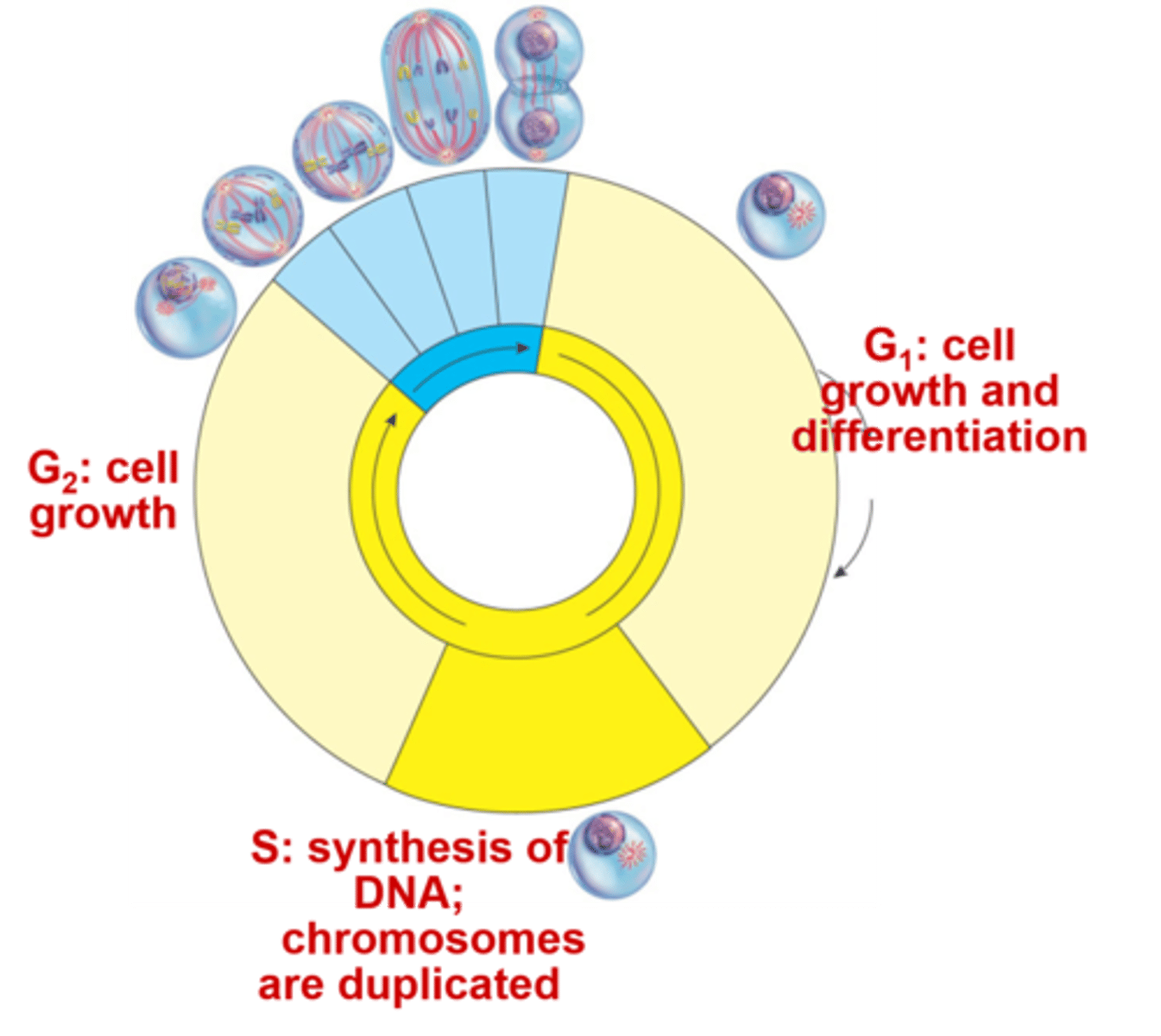
mitosis
division of the nucleus
DNA is equally distributed into 2 daughter nuclei
cytokinesis
division of cytoplasm that forms 2 separate daughter cells, each containing a single nucleus
chromosomes
threadlike structures composed of chromatin (DNA & proteins)
breakdown of genome
genome → chromosomes → chromatin → DNA + proteins
DNA replication
2 chromosomes attached at centromere called sister chromatids
-produces replicated chromosome w/ 2 identical sister chromatids

sister chromatids
separate during mitosis, each forms individual chromosome
karyotype
pairs of chromosomes arranged by size, shape and staining pattern
homologous chromosomes
pair of chromosomes that contain the same genes; have same size, centromere position and staining pattern
NOT the same as replicated chromosomes
one is from mother, one is from father
human cells contain how many chromosomes?
46 chromosomes/23 pairs of homologous chromosomes
autosomes
non-sex chromosomes
22 pairs in cells
haploid
cells contain one set of chromosomes, only found in gametes
gametes
haploid egg/sperm cells & contain half # of chromosomes as ordinary cells
zygote
2 haploid gametes unite during fertilization
fertilized egg
mitosis
nuclear division
5 phases: early & late prophase, metaphase, anapahse, telophase
spindle apparatus
part of cytoskeleton
separates chromosomes into daughter cells
early prophase
step 1 of mitosis
chromatin condenses
spindle apparatus forms
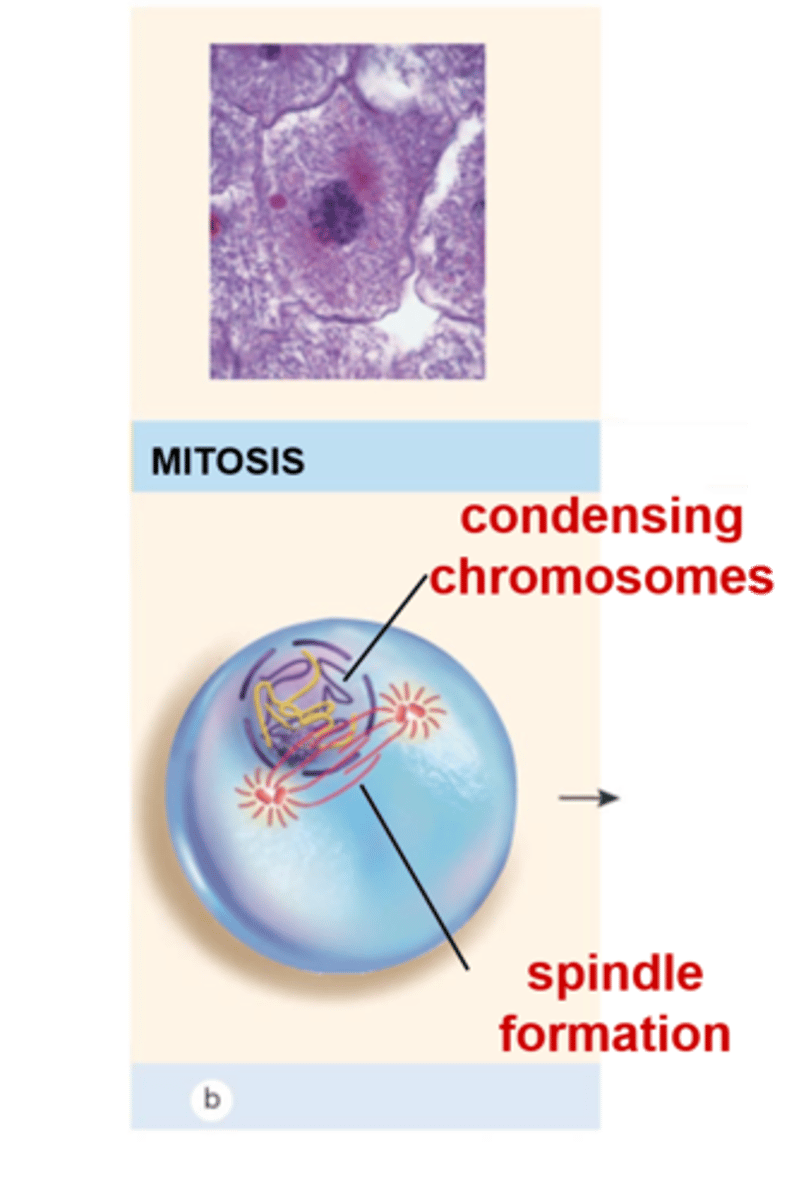
kinetochores
protein structures on chromosomes where spindle fibers attach during mitosis
late prophase
step 2 of mitosis
nuclear envelope disappears
microtubules attach to kinetochore
polar microtubules radiate towards cell's equator, each microtubule attaches to separate sister chromatid

metaphase
step 3 of mitosis
chromosomes move to & align on the equator of the cell
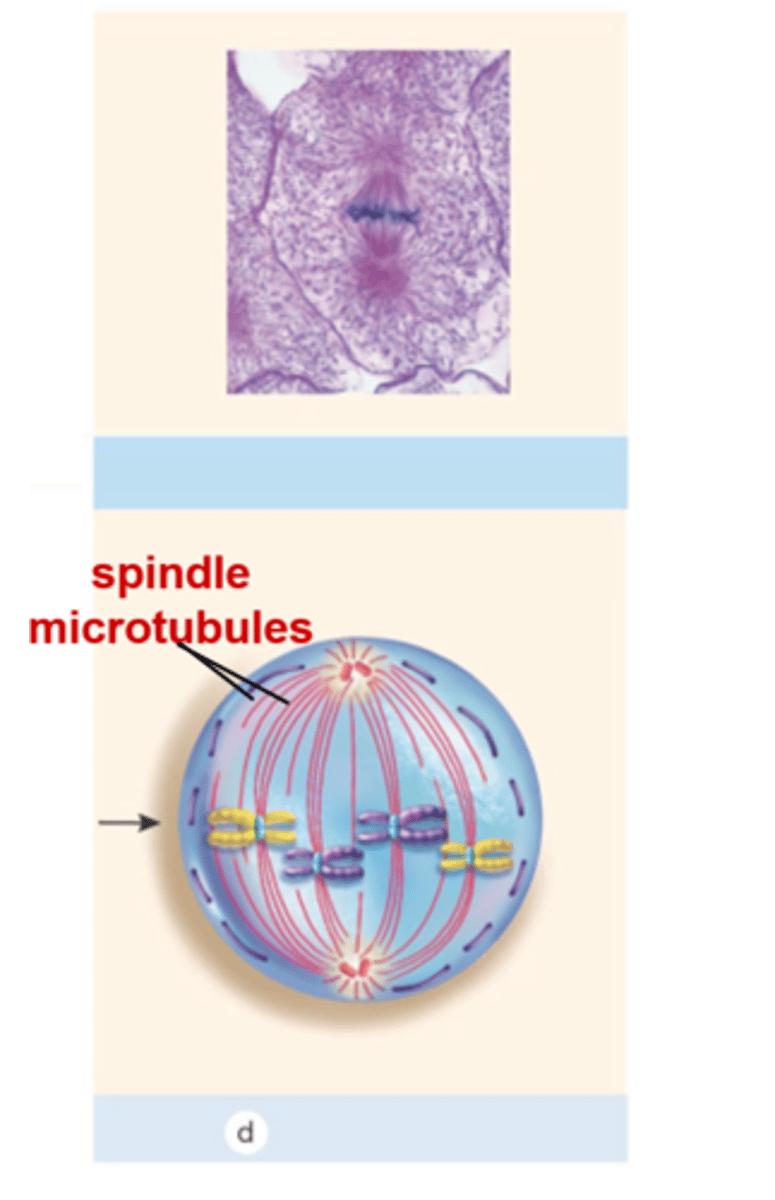
anaphase
step 4 of mitosis
sister chromatids divide into separate daughter chromosomes & move toward opposite poles
movement of chromosome is accomplished by depolymerization of microtubules at kinetochore (break apart)
cell begins to elongate b/c polar microtubules slide past each other & push poles apart
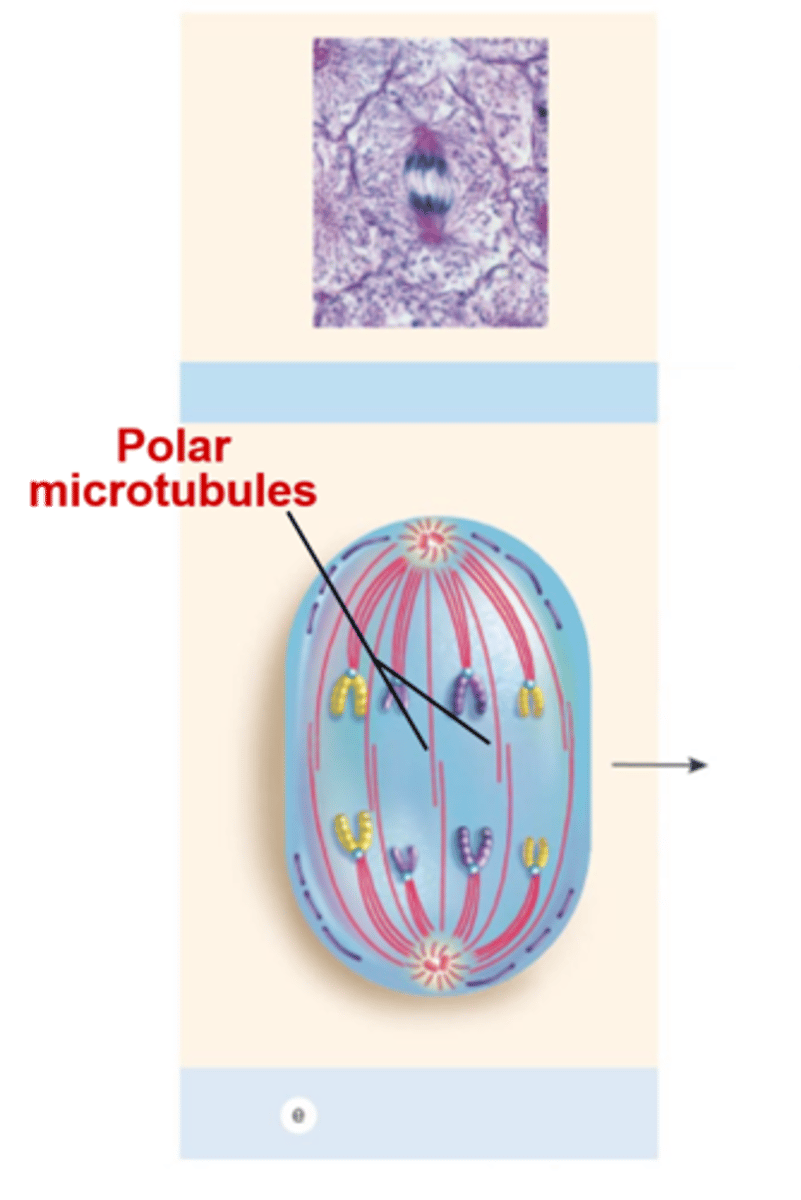
telophase
step 5 of mitosis
daughter chromosomes arrive at poles
kinetochore microtubules diappear
polar microtubules elongate, helps causes the formation of the cleavage furrow
daughter nuclear envelopes form
chromatin begins de-condensing
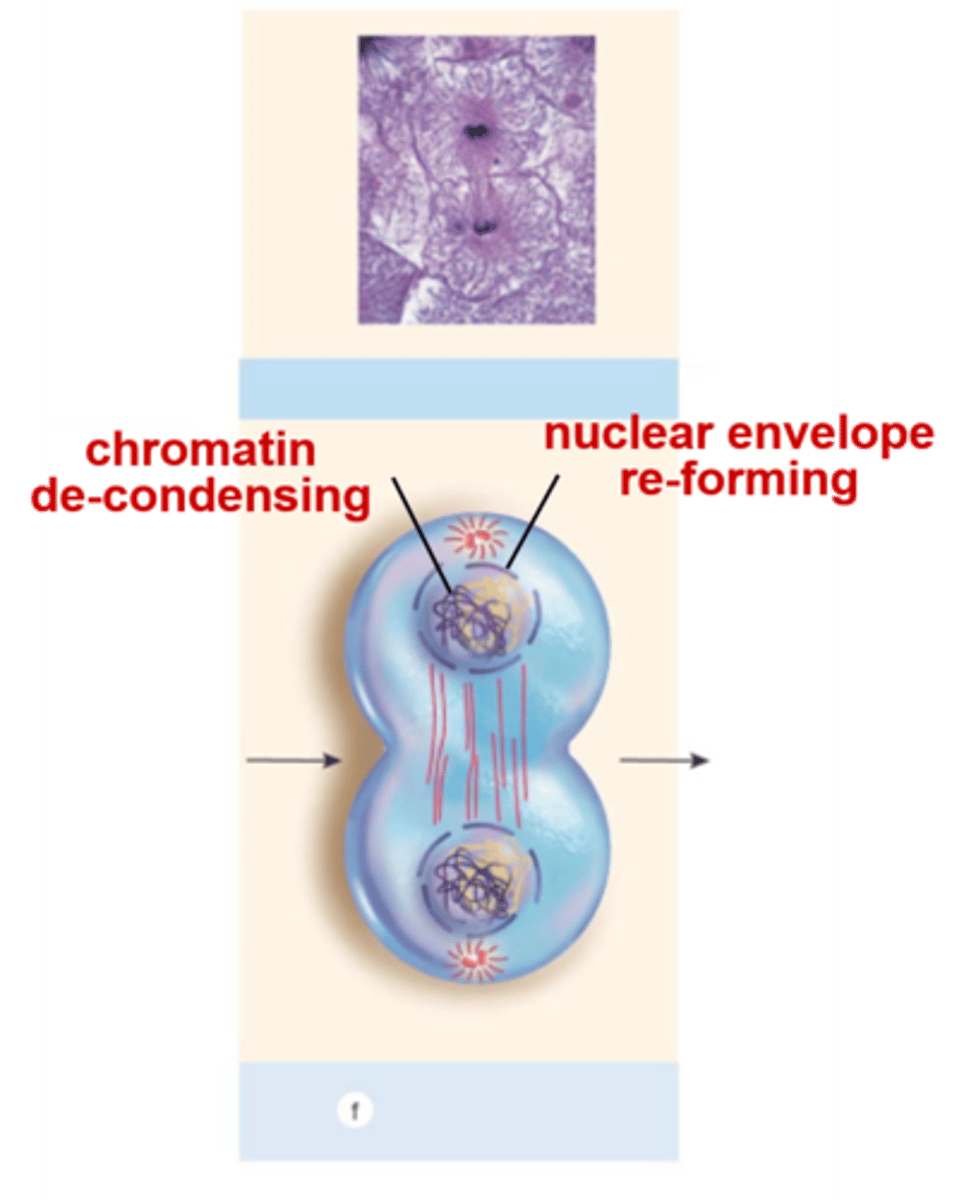
asexual reproduction
one parent
single parent passes ALL genes
rare genetic differences are result of mutations
sexual reproduction
two parents each pass half of their genes
greater genetic variation w/ offspring being genetically different from parents & siblings
meiosis
occurs in ovaries and testes
meiotic division followed by 2 rounds of cytokinesis to produce 4 daughter cells that become gametes
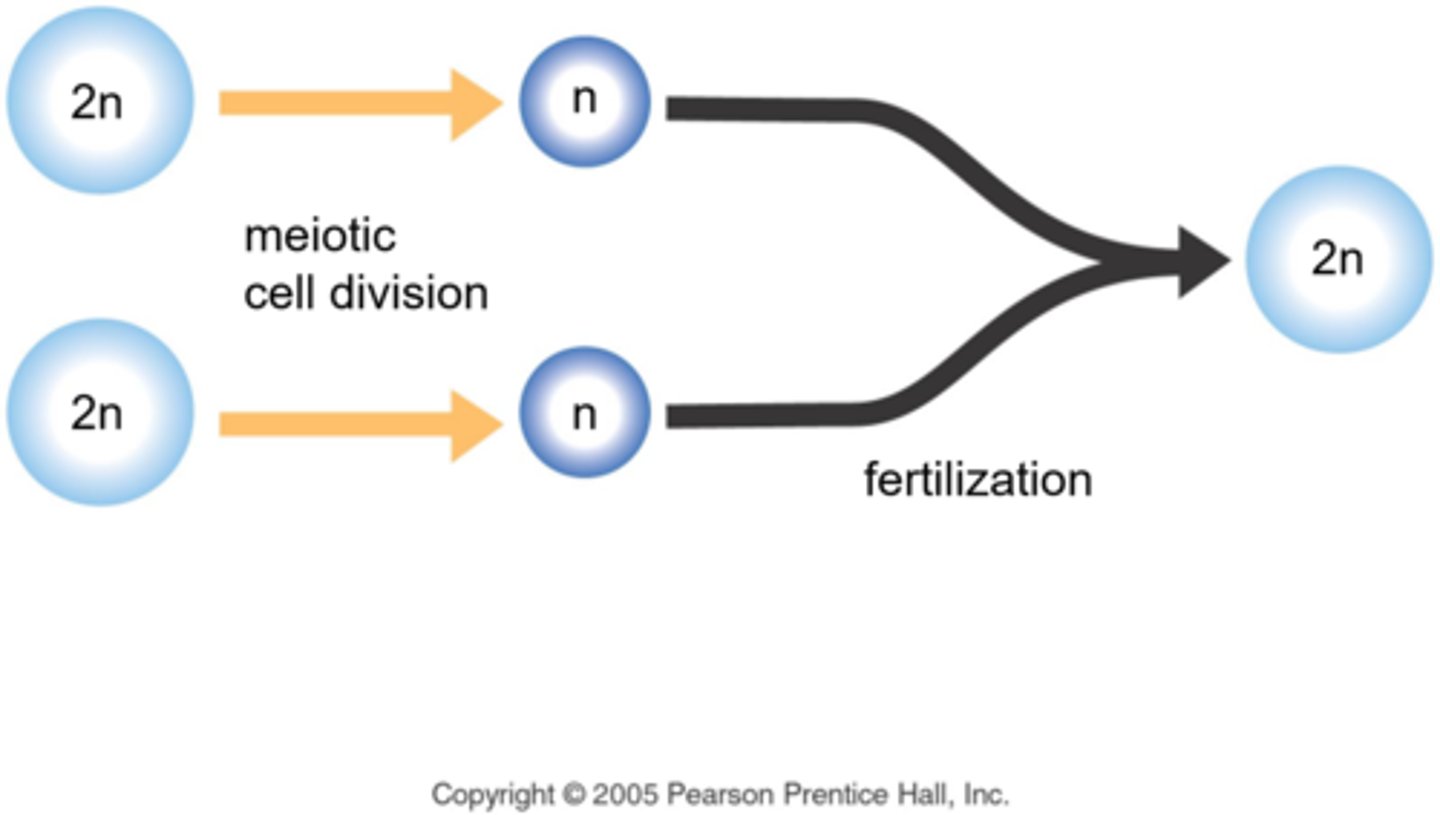
meiosis II
separates sister chromatids & puts on chromatid into each daughter nuclei
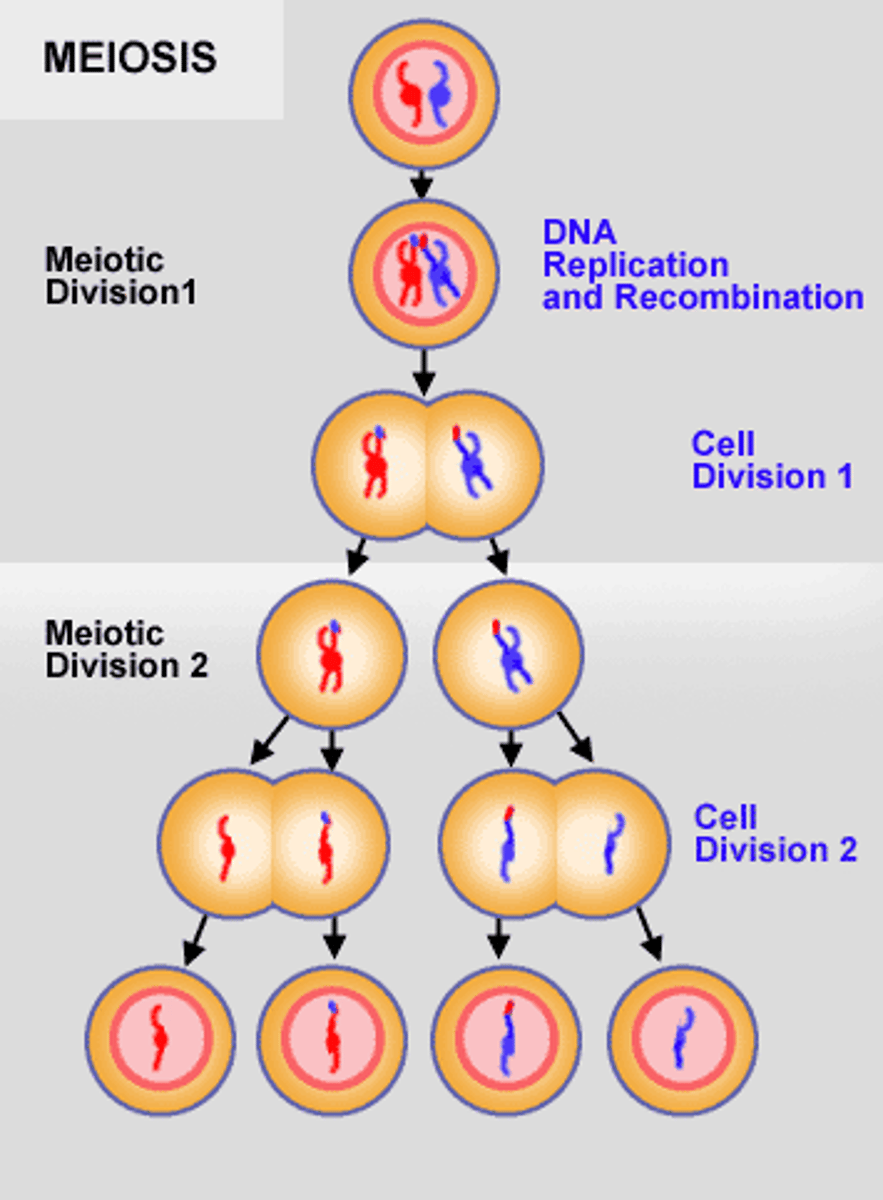
meiosis I
homologous chromosomes pair up
sister chromatids linked at centromere, non-sister chromatids linked at chiasmata
exchange of genetic info btw un-identical chromosomes
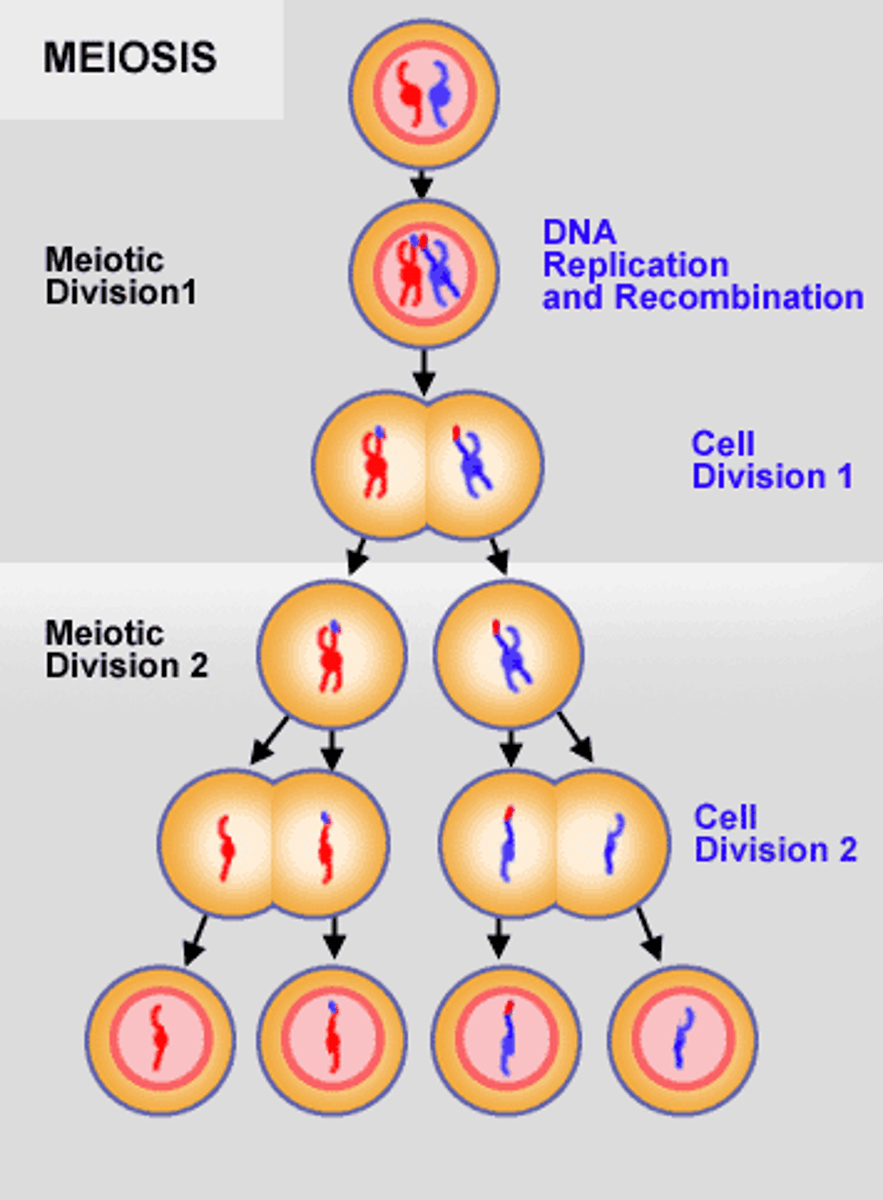
meiosis 1: prophase 1
chromosomes condense and pair up,
sister linked at centromere, non-sister linked at chiasmata
genetic crossing over
nuclear envelope disappears
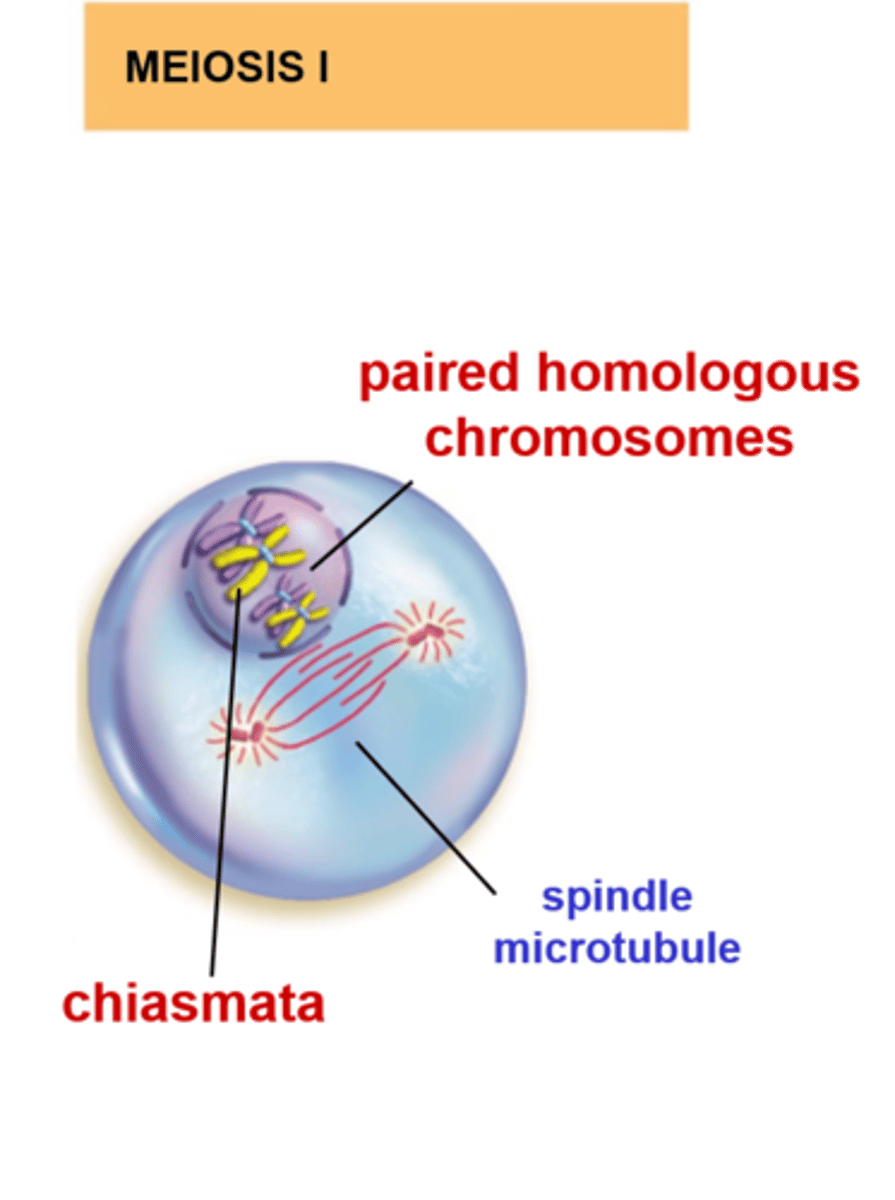
chiasmata
regions of paired homologous chromosomes where chromatids have exchanged genetic material b/c crossing over
meiosis I: metaphase I
chromosome pairs align at equator
kinetochores face same pole
centromeres of homologous face opposite poles
meiosis 1: anaphase 1
spindle microtubules interact w/ kinetochore fibers
homologous chromosomes move toward opposite poles
sister chromatids remain attached
meiosis 1: telophase 1 and cytokinesis
chromosomes arrive at poles
cell divides
meiosis II final result
prophase II, metaphase II, anaphase II, telophase II
cell division occurs creating four haploid daughter cells
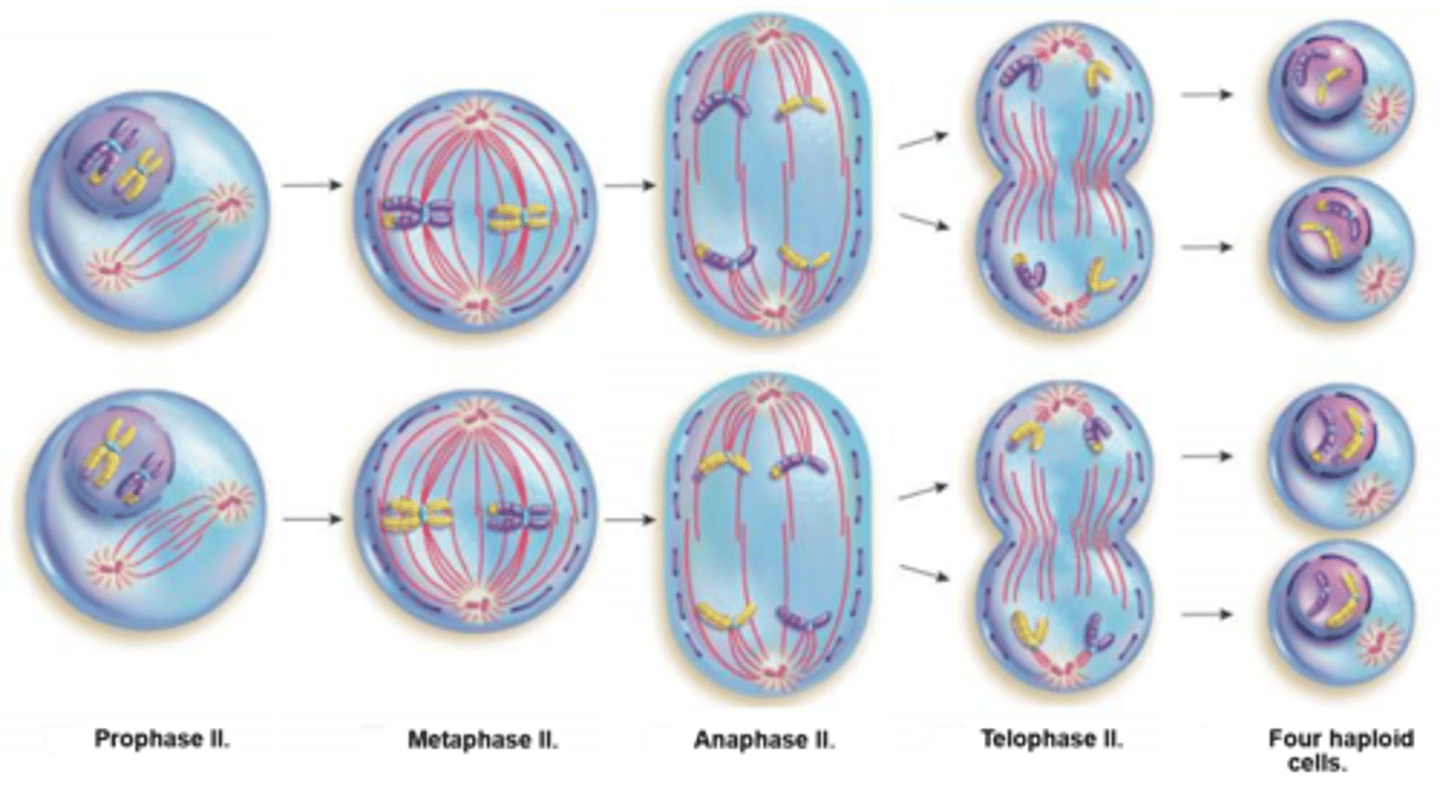
difference btw mitosis and cytokinesis
mitosis is division of the nucleus
cytokinesis is actual division/division of the cytoplasm